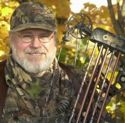The Eastern Kingbird (Tyrannus tyrannus) is a snappy dresser, an aerial artist that catches its prey on the wing, and spends the winter in tropical climes.
Its demeanor and distinctive plumage are all business — upright posture, white shirt (breast), and dark suit — gray head, back, wings and white-tipped square tail.
Coloration is similar to the Eastern Phoebe (Sayornis phoebe), but the Eastern Kingbirds is larger, on average about 8 1/2 inches tall, with a wingspan of 13 to 15 inches, and weighing about 1 1/2 ounces.

The Eastern Kingbird is abundant in Central and Western Kentucky, but less common in more than a dozen heavily-forested counties of Appalachia, from Bell and Clay counties in the south, west to Breathitt, and north to Martin and Pike counties.(Photo from the Audubon Society)
Range and Distribution
The Eastern Kingbird is abundant in Central and Western Kentucky, but less common in more than a dozen heavily-forested counties of Appalachia, from Bell and Clay counties in the south, west to Breathitt, and north to Martin and Pike counties.
This member of family Tyrannidae, the tyrant flycatchers, includes more than 400 species throughout North and South America.
Its breeding range extends from northern British Columbia, east to the Canadian Maritime Provinces, South to Florida, and west to central Texas, but the bird is absent from the desert Southwest and Pacific coast.
Audubon Society surveys show a gradual decrease in numbers since the 1960s, but it is still common throughout its range, where suitable habitat is present.
A long-distance migrant, the Eastern Kingbird spends its winters in the forests of South America, where it feeds primarily on fruit (berries). They migrate in flocks, traveling by day.
Eastern Kingbirds begin their southward migration early, in late summer, with very few remaining on their breeding grounds by early September.
They return to Kentucky in late April, to establish territories, which they fiercely defend.
Habitat
In The Kentucky Breeding Bird Atlas, author Brainard Palmer-Ball Jr. wrote: “Eastern Kingbirds are birds of semi-open to open habitats with scattered trees…most conspicuous in rural farmland, also suburban parks, riparian corridors, open wetlands, reservoir margins, and reclaimed strip mines.”
In highly altered habitats, such as the Inner Bluegrass Region, there are high numbers of this species.

The Eastern Kingbird’s summer diet is mostly insects — beetles, wasps, bees, winged ants, grasshoppers, flies, and leafhoppers (Photo from the Audubon Society)
Food Habits
The Eastern Kingbird forages from a perch. When it locates an insect, it flies out to catch it in mid-air or may hover, to snatch a bug or fruit (berry) off a limb.
Its summer diet is mostly insects — beetles, wasps, bees, winged ants, grasshoppers, flies, and leafhoppers. In winter, it feeds on berries and other wild fruits, while on the ground.
Reproduction and Nesting
The male displays during courtship with a number of impressive aerial acrobatics, including rapid up-and-down flight, zigzags, and backward somersaults.
In Kentucky, egg laying may commence the second week of May but doesn’t peak until early June. Second clutches are uncommon, usually the result of re-nesting after a loss of eggs or young from severe weather or predation.
The nest site is usually in a deciduous tree or large shrub, typically 7 to 30 feet above the ground.
The female builds the nest, sometimes with the help of the male — a cup of weeds, twigs, and grass, lined with soft material, including animal hair or down.
Typically, three to five white to pinkish-white eggs, heavily blotched with brown, lavender, and gray, are laid. Incubation by the female is about 16 to 18 days. Both parents bring food to the nestlings, which fledge, and can fly in about two to three weeks.
The Eastern Kingbird is a beautiful, acrobatic bird often observed along rural backroads, perched on a tree limb, fence, or powerline. Look for their “business suit” gray and white plumage, and distinctive white-tipped square tail.
But they won’t here for long. Before summer’s end, they’ll be headed south to the sunny tropics for the winter.

Art Lander Jr. is outdoors editor for KyForward. He is a native Kentuckian, a graduate of Western Kentucky University and a life-long hunter, angler, gardener and nature enthusiast. He has worked as a newspaper columnist, magazine journalist and author and is a former staff writer for Kentucky Afield Magazine, editor of the annual Kentucky Hunting & Trapping Guide and Kentucky Spring Hunting Guide, and co-writer of the Kentucky Afield Outdoors newspaper column.






















